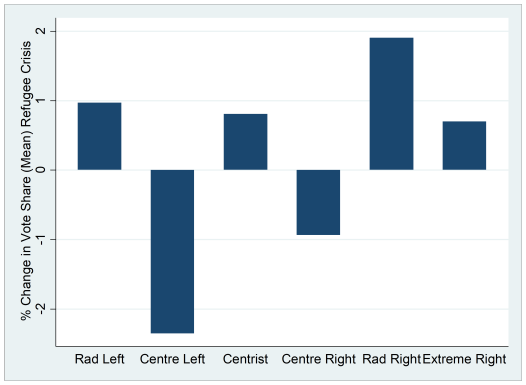
Valerio A. Bruno
Twenty-first century European politics has been characterised by patterns of electoral volatility, alongside the recent economic and ongoing refugee crisis. This has allowed ‘populist’ parties on both the right and left to capitalise on the electoral failure of mainstream centre left and right parties.
There has been a considerable amount of research on the recent rise of populist radical right and populist radical left parties. A number of studies have shown that these parties have shaken up the political landscape in contemporary European politics during times of economic and political crisis. But surprisingly few studies have examined the electoral fortunes of radical right and left parties together.

James F. Downes
Electoral gains
The figure below demonstrates that in the last two national parliamentary elections that fall across the recent refugee crisis period, the radical right made the largest electoral gains in EU countries. Mainstream centre left parties suffered the largest losses, underlining the electoral downfall of this party family in the post-economic crisis period and wider anti-incumbency effects. Radical left parties performed well electorally, but their electoral gains were considerably lower than those of radical right parties.
Figure: Percentage vote share change for different types of political parties (last two national parliamentary elections amongst the EU28)
Source: Authors’ own dataset (Downes, 2018)
The radical right has made considerable use of the refugee crisis to build its support. Two of the most striking examples are the 2017 Austrian legislative election which ultimately saw the Freedom Party of Austria (FPÖ) entering into coalition with the centre right Austrian People’s Party (ÖVP), and the 2018 Italian legislative election, which saw the radical right League enter into a coalition with the Five Star Movement.
Become a Social Europe Member
Support independent publishing and progressive ideas by becoming a Social Europe member for less than 5 Euro per month. Your support makes all the difference!
Those radical left parties which have made gains in recent national parliamentary elections include the Left Bloc (BE) in Portugal, which substantially increased its vote share in the 2015 Portuguese legislative election. Other parties, such as Syriza in Greece, and Podemos in Spain, have achieved notable electoral success over the last decade. It is important to note however that this success is not uniform, with some parties faring less well electorally and others facing challenges maintaining their support.
The radical right’s winning formula
What factors can explain the electoral success of radical right parties in the post-economic crisis period? First, the party strategy of the radical right has tended to be simple and clear, with a focus on issues such as immigration and an attempt to link this directly to general discontent and dissatisfaction with the EU. Second, the radical right has a much broader voter base to target with this narrative than radical left parties have. Recent research has shown that radical right parties have the ability to attract traditional working-class voters away from centre left parties, primarily due to their effective use of the immigration issue.
The simplicity and clarity of the radical right message has been a key part of their success. Powerful images of nationhood have combined with fears over issues such as immigration to drive this support. Capitalising on popular fears has been shown by previous research to be a core element of the radical right narrative. And the ‘accessibility’ of this message is arguably one of the most important differences between the approach of the radical right and the radical left.
In contrast, the radical left remains to some extent a platform for abstract intellectual ideas. Such narratives are far more difficult to translate into the slogans and messages which have proven successful in the digital age of politics. The perceived inability of the radical left to form concrete policy responses to the global economic crisis has not helped their cause. The radical left has in many cases failed to weave together a clear and simple narrative on the economy which can rival the message of the radical right, while it has also been less willing to focus on the key issue of immigration which the radical right has used so effectively to attract support.
Radical right parties have ultimately been better placed to offer a clear ‘populist’ message on issues such as immigration and the EU, thereby capitalising on the disaffection of voters. But understanding the reasons why the radical right, as opposed to the radical left, has proven particularly adept at winning support will be of obvious importance for European politics in the coming years as the electoral power of populism is unlikely to disappear in the short-term.
This post originally appeared on the European Politics and Policy (LSE) blog and is based on the authors’ working paper “The Electoral Success of the Radical Right in Europe (2013-2018): Why are the Radical Right better at “capitalizing” on ‘Populism’ than the Radical Left?”
Valerio Alfonso Bruno holds a Ph.D. in “Institutions and Policies” from the Università Cattolica del Sacro Cuore of Milan (2017) and was doctoral researcher at the University of Fribourg, Switzerland (2015). James F. Downes is a Lecturer in Comparative Politics in the Department of Government and Public Administration at the Chinese University of Hong Kong. He is an Affiliated Visiting Research Fellow (Honorary) at the Europe Asia Policy Centre for Comparative Research. He is also a Data Advisor for the Local Democracy Dashboard project, based at the London School of Economics.

